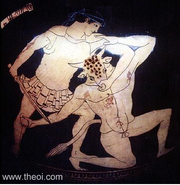
Description[]
Although Ariadne was born a human, many myths still regard her as a Goddess of Passion and Labyrinths. This is because of her endless love for both Theseus and Dionysos, and her important role in helping Theseus to escape the Labyrinth in the myth of the Minotaur. There are not many descriptions of her physical characteristics in myths; however some say she has brown hair while others state she had blonde.
Origin/Myth[]
Ariadne was originally a human, born to the King and Queen of Crete. After making a deal with Theseus to help him during his mission to kill the Minotaur, she left with him to return to Athens and become his wife. However, abandoned by Theseus on the island of Naxos, she married Dionysos, who either kidnapped or saved her. Once she passed away from old age, or in some myths killed herself out of despair, Dionysos supposedly, out of love, went down to Hades and had her reborn as an immortal. Whether or not she actually became a Goddess depends on the myth. Another version states that once Ariadne arrived on the island, distraught, she encountered a religious festival honoring Dionysos. The cult needed a sacrifice, and she was willing to participate. After she was killed by the revelers and brought to Hades, Dionysus was so impressed by her beauty and willingness to participate in his ceremony that he married her and granted her immortality. (Go to other myths for the details of this myth)
Family[]
Ariadne was the wife of the Wine God Dionysos. Her father was King Menos of Crete while her mother was Pasiphae, the daughter of Helios, the Sun God. Ariadne's sister is Phaedra, also a human. She had many children although depending on the myth, was born to either Theseus or Dionysos. Her children include Oinopion, Staphylos, Thoas, Tauropolis, Euanthes, Latromis, Peparethus, Phliasus and Eurymedon.
Other Myths[]
Story of the Minotaur:

The Minotaur was born to Pasiphae, Ariadne's mother, and a bull sent from Poseidon. Poseidon made Pasiphae fall in love with the bull because it was originally given to King Minos as a gift; however, he refused to sacrifice it to Poseidon. The Minotaur was half bull, half human, and hidden in the Labyrinth in the Minoan Palace at Knossos, constructed by Daedalus. Enemies would be sent there, for there is no way to make it out alive without being killed by the Minotaur first. After Androgeus, son on King Menos, was killed in Athens, during the Panathenaic Games, by the bull that created the Minotaur, King Menos ordered King Aegeus of Athens to send 7 women and men every year to the Minotaur in order to avenge the death of his son. The son of Aegeus, Theseus was among one of the 7 men to attempt to kill the Minotaur one year. Although he might have been able to kill the Minotaur, he would have no way of escaping the Labyrinth. When he met Ariadne, daughter of King Menos, she fell in love with him and agreed to help him if he promised to marry her when they arrived back in Athens. She consulted Daedalus, and he gave her a thread. Therefore, as Theseus traveled through the Labyrinth, he would always know the way back. Once he successfully killed the Minotaur while he was sleeping and followed the thread back to the entrance, he, Ariadne, and the other young Athenian sacrifices headed on their journey home. Before returning to Athens, they stopped on the island of Naxos to celebrate. Here, Ariadne was either deliberately or accidentally abandoned while sleeping, later to be rescued by Dionysus. (Go to origin/myth for the end of this myth)
Powers []
Ariadne, since she was not technically a God, only a human, she possessed no powers.
Other Interesting Facts[]
Ariadne was given a crown by Aphrodite as a wedding gift when she and Dionysos were married. Once she died, Dionysos placed the crown in the sky to illustrate his love. This crown, formed by the stars at night, is now known as the Corona Constellation.
Works Cited[]
Atsma, Aaron J. "Ariadne: Goddess Wife of Dionysos." Theoi Greek Mythology. Theo Project, 2000. Web.
10 Apr. 2013. <http://www.theoi.com/Georgikos/Ariadne.html>.
Parada, Carlos. "Ariadne." Greek Mythology Link. Carlos Parada and Maicar Forlag, 1997. Web. 10 Apr.
2013. <http://www.maicar.com/GML/Ariadne.html>.
Trckova-Flamee, Alena, Dr. "Ariadne." Encyclopedia Mythica. 2013. Encyclopedia Mythica Online.
11 Apr. 2013 <http://www.pantheon.org/articles/a/ariadne.html>.